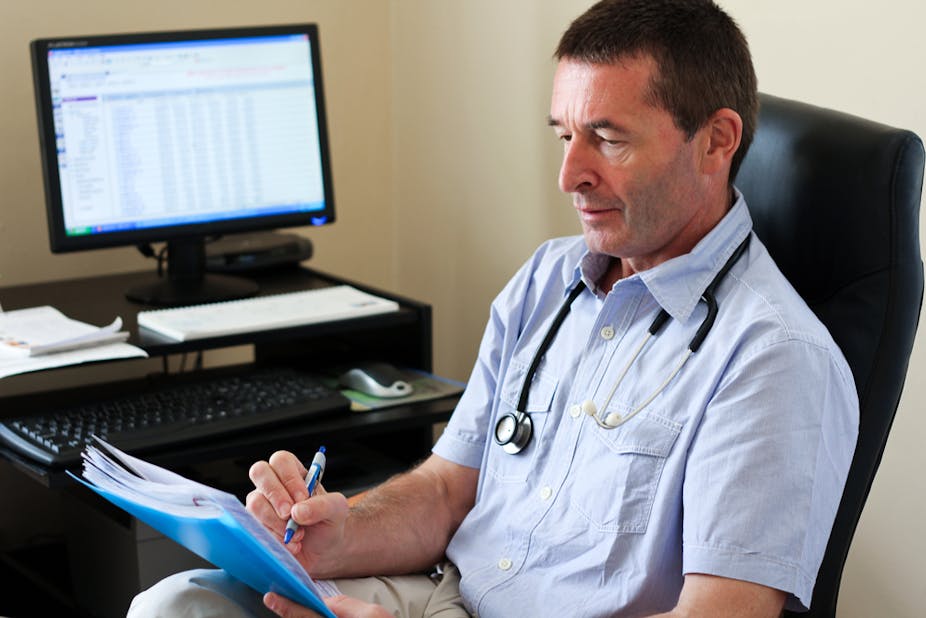It seems that almost every politician, health economist, policy expert and health-care worker has a different take on the state of the nation’s health system and ways to make it more sustainable. But notably absent from the debate so far is the role of technology.
So, how can digital innovation improve the health system’s bottom line?
Rising health costs
We know that Australia’s health system, in its current form, is not sustainable. Treasury projections show that we currently spend more than 20% of all government tax revenue on health, and that if current trends continue, this will rise to 40% by 2043.
State government expenditure is even more dire, currently at 40%, and rising to 100% in the same period. Over the past ten years, health-care spending has risen faster than the growth of our gross domestic product (5.4% vs 3.1%) and in 2012 health overtook retail as Australia’s largest employment sector.

The drivers of this growth are an ageing population that is living longer but not in good health, increasing rates of chronic disease (such as diabetes, heart disease, cancer and asthma) that require long-term health management, and increasing expectations around medical advances and what our health system can treat.
For my grandparents’ generation, the expectation for failing hip joints was a pair of walking sticks and self-management. Today, we expect hip replacement surgery, and new hips. The social outcome today is much greater, but there is an economic cost that we need to acknowledge.
The exact maximum proportion of our national budget that can sensibly be spent on health is still up for debate, however it is clear that this limit is in sight. So, economically speaking, what are the alternatives?
Keeping a lid on spending
One approach is to look for new sources of funding into the system. Individuals already fund nearly 20% of health-care expenses through out-of-pocket payments. The current proposal of GP co-payments is one way to increase this.
But when people can choose how they interact with the health system, they will generally opt the lowest-cost option (to them) that meets their needs. So, if they have to pay to visit their GP, then they are more likely to go to the emergency department at their nearest public hospital as an alternative – at much higher cost to the health system.

A second approach is to look at how the system spends the current funding, and whether it is possible to improve what is achieved with the current budget. The best places to seek these improvements are the parts of the health system with the biggest expenditure, which are hospitals (40%), and medical services (18%).
Savings could be found through efficiency gains (doing the same things, but in smarter ways), better utilising lower cost parts of the health-care system that meet patients needs, and by changing operating models (doing smarter things to get desired outcomes).
Technological solutions
There is a growing collection of technological solutions that started as research to demonstrate their clinical safety and economic value, and are at, or rapidly moving towards, early roll out.
Big data analytics can predict who, when and why patients arrive at hospitals. These tools can predict emergency department arrivals and how many will need admission, and days when there will likely be insufficient beds available to meet these needs.
This kind of forecasting enables hospitals to move from reactive planning (need a bed now), to proactive planning for emergency department and elective surgery needs, and look to reduce waiting times, improve bed usage, and reduce staff stress levels along the way.
Decision-making around how patients are discharged from hospital is equally important, including understanding and overcoming the barriers that keep people in hospital after they are clinically ready to go.
Patients with chronic diseases, for instance, are high users of our health-care system. For some of these patients, there is growing evidence that their needs may be better met – clinically and economically – through guided self-care at home using broadband communications.
In rural areas, broadband can also improve access to essential health services, enabling better early diagnosis and treatment of conditions before they become major and require hospitalisation. CSIRO is helping to deliver specialist ophthalmology (eye care) services, for example, to remote communities in Southwest Western Australia and the Torres Strait Islands.

At CSIRO, we are also exploring the options to take patient prediction tools to the next level: whether forecasting can also predict health deterioration. This would enable simpler, earlier medical intervention, saving the social and economic cost of a visit to hospital.
The health system is going through a profound generational change in the transition from paper to fully electronic records. The computational standard SNOMED CT is emerging internationally as the tool that will enable these records to exchange detailed, precise concepts and information.
Figuring out how to implement and manage the complexities of the standard across the many non-standard (and often text-based) health record systems is a research challenge in itself. But once implemented, the potential for big data analytics, machine learning and decision support will result in higher quality and safer patient care, as well as enormous efficiency gains in reporting, health business systems, and population health.
Australia is rightfully proud of our record of medical research achievements. But there is a strong case to refocus a significant part of our investment in clinical research towards building an equally strong capability in health-care services research.
Finding ways to deliver high-quality care with good patient outcomes at an affordable cost to the nation is just as important as finding cures for diseases.

